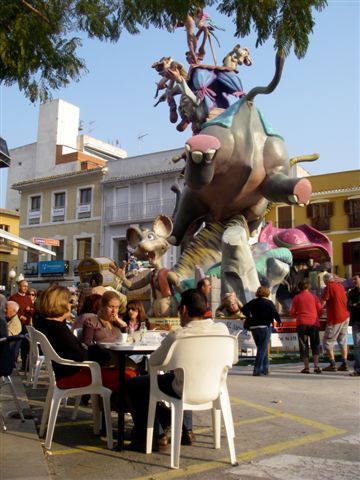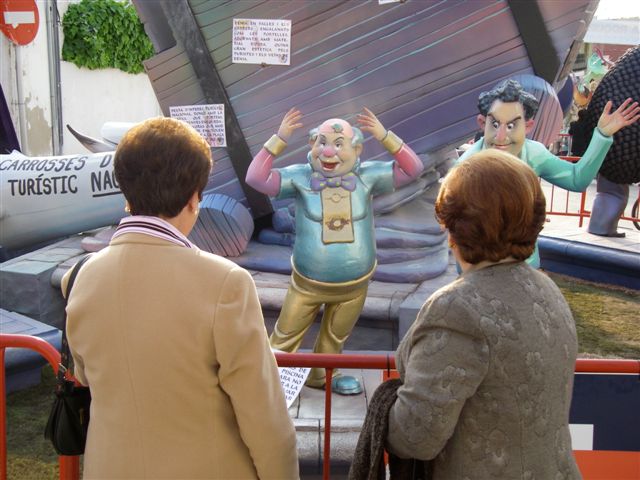The photographs were taken last weekend in the town of Denia, while the article appeared in The Sunday Times in 2001.
Juan Llantada pulled a face, not unlike an iguana, and offered some advice; "During the ten minutes of the Mascaleta you must keep your mouth slightly open, like this" he said, repeating his reptilian contortion. "It will prevent the explosions damaging your inner ears". Continues
The Mascaleta was psychological warfare. Before going into battle, the Arabs, who ruled much of Spain for centuries, shot powerful fireworks into the sky to intimidate their opponents, and those skills are still used at Fiesta time.
For one week in March, the province of Valencia gives itself over to the most primal of urges and celebrates the secret of fire. Towns and tiny villages reverberate to an almost continuous cacophony of fire crackers and marching bands, all watched over by huge, cartoon-like effigies, specially built for this unique celebration. Then, at the very climax of the week long fiesta, these lovingly created monster models are set alight and completely destroyed in an orgy of flame.
 Today, different neighborhoods still compete to produce the best fallas, only now they commission specialist artists, sculptors and craftsmen to create, transport and erect the final statues. A small town of fallas engineers has grown just outside Valencia, providing employment for thousands of people. But modernisation has not diminished their power to puncture pomposity, to comment on social trends, or to poke fun. It must be a humbling experience for a politician to see himself go up in flames - a spitting image, spitting real fire.
Today, different neighborhoods still compete to produce the best fallas, only now they commission specialist artists, sculptors and craftsmen to create, transport and erect the final statues. A small town of fallas engineers has grown just outside Valencia, providing employment for thousands of people. But modernisation has not diminished their power to puncture pomposity, to comment on social trends, or to poke fun. It must be a humbling experience for a politician to see himself go up in flames - a spitting image, spitting real fire.I found my first falla by following a procession through the Costa Blanca town of Gandia, and the sight of it stopped me in my tracks. Towering thirty feet over head, looming as if about to pounce, was the soulful, bearded face of a wizened old man. Father Time clutched an immense candlestick in one hand and, in the other, raised aloft a ball from which a sprite stared down in fear and anger.
That was the central theme, but other tableaux were dotted around the base; an old man was slumped in a chair reading a book, while his grandchild sat on his knee, engrossed in a video game. A local politician, who I was told had recently introduced Gandia's confusing one-way traffic system, struggled under a pile of cartoon cars. Small local issues, global social trends, and the mortality of man juxtaposed with the infinite quality of time were all encompassed in one gaudy, magnificently monstrous sculpture. It was my first falla and it will always be the best. But I'd heard the really impressive ones were to be found in the big city of the Levantine plain.
No fewer than three hundred and seventy fallas are dotted around the city, each a huge structure, each organised and paid for by a different district, and each erected in a different square, sometimes squeezed in so tightly they almost touch the surrounding buildings. It shows a powerful sense of local pride and willingness to work together which I cannot imagine happening anywhere else.
 They save the best until last. The crema is the epic conclusion of the fiesta, and I decided to experience it in the second city of fallas, the town of Denia. Each falla is judged and, like a macabre Miss World pageant, they are ignited in reverse order.
They save the best until last. The crema is the epic conclusion of the fiesta, and I decided to experience it in the second city of fallas, the town of Denia. Each falla is judged and, like a macabre Miss World pageant, they are ignited in reverse order.
This being Spain, no-one actually expected the fire to start on time, so no-one was disappointed when, by half past twelve, nothing had happened. The crowd pressed closer, willing, shouting, whistling and cheering for the man with the lighter to do his job.
Then suddenly all hell was let loose. Although I'd paid it little attention, a rope encircled the falla, about twelve feet from the ground and dangling from it, just overhead, were lots of small paper parcels. These now sprang into explosive life, as fire crackers and catherine wheels fired off a fusillade of flame and a shower of sparks. People screamed and ducked for cover from the scalding slivers. Crowd control by firework proved highly effective because in an instant, everyone had retreated to where the fire department, the bombers, had been asking them to stand all along. Barriers were dragged in front of the startled, smouldering audience, and the crema began.
 At first there was barely a hint of a flame. I thought the fire had not caught hold. Then I realised the falla was burning from the inside. With a 'crack' one of the supports gave way and a ball of fire belched through the gap, silhouetting the huge caricature in an unholy orange glow.
At first there was barely a hint of a flame. I thought the fire had not caught hold. Then I realised the falla was burning from the inside. With a 'crack' one of the supports gave way and a ball of fire belched through the gap, silhouetting the huge caricature in an unholy orange glow.
With the flame came the heat, fantastic heat, radiating from the falla with a power ten times that of the explosions of the mascleta. Around me, people clamped their hands over their foreheads to protect the expanse of bare flesh. The following morning, I would discover that the skin on my brow had peeled, such was the intensity of the heat, but for now I hid behind my camera, struggling with exposure settings, trying to get close enough for a shot but being driven back by the blaze.
That night I watched three fallas rise in flames and fall into ashes. The build up to each ignition took longer and longer, as none could begin until the bombers arrived and this, not surprisingly, is their busiest night of the year. One falla, erected in a particularly narrow street, could only be lit after the neighbouring buildings had been doused with water to protect them, and a fire hose played across their balconies for the duration of the conflagration.

Six hours later, with the morning just starting to take shape, I stood at the same spot, staring at a pile of damp ashes and wondering. Why go to the expense of shutting down towns and cities along the Costa Blanca? Why build elaborate statues just to destroy them? Why risk life and property for a moment of incandescent madness?
It seems to me that this is not really about a Saint's day, or lampooning powerful people, or even using up carpenters' cast offs. Such things are part of it, but the fallas festival is far more fundamental, more elemental. It represents the eternal cycle of creation and destruction, of light and dark, of life and of death, and these truths still exert a powerful influence in Iberia.
The morning after the crema, the planning always starts again for next year, because the fallas is simply a spectacular part of an eternal cycle which can never be broken.
When to go: Saint Joseph's day is celebrated on 19th March. The Fallas festival runs for a week up to the weekend nearest this date.
Where to go: Valencia is the capital of Fallas, and the hotel prices reflect this. By contrast, Denia is big enough to have the atmosphere but small enough to watch almost every crema. Costa Blanca towns which have Fallas festivals include: Benidorm, Bunol, Calpe, Denia, Gandia, Oliva, Pego, Sueca, Valencia.
This being Spain, no-one actually expected the fire to start on time, so no-one was disappointed when, by half past twelve, nothing had happened. The crowd pressed closer, willing, shouting, whistling and cheering for the man with the lighter to do his job.
Then suddenly all hell was let loose. Although I'd paid it little attention, a rope encircled the falla, about twelve feet from the ground and dangling from it, just overhead, were lots of small paper parcels. These now sprang into explosive life, as fire crackers and catherine wheels fired off a fusillade of flame and a shower of sparks. People screamed and ducked for cover from the scalding slivers. Crowd control by firework proved highly effective because in an instant, everyone had retreated to where the fire department, the bombers, had been asking them to stand all along. Barriers were dragged in front of the startled, smouldering audience, and the crema began.
With the flame came the heat, fantastic heat, radiating from the falla with a power ten times that of the explosions of the mascleta. Around me, people clamped their hands over their foreheads to protect the expanse of bare flesh. The following morning, I would discover that the skin on my brow had peeled, such was the intensity of the heat, but for now I hid behind my camera, struggling with exposure settings, trying to get close enough for a shot but being driven back by the blaze.
That night I watched three fallas rise in flames and fall into ashes. The build up to each ignition took longer and longer, as none could begin until the bombers arrived and this, not surprisingly, is their busiest night of the year. One falla, erected in a particularly narrow street, could only be lit after the neighbouring buildings had been doused with water to protect them, and a fire hose played across their balconies for the duration of the conflagration.
Six hours later, with the morning just starting to take shape, I stood at the same spot, staring at a pile of damp ashes and wondering. Why go to the expense of shutting down towns and cities along the Costa Blanca? Why build elaborate statues just to destroy them? Why risk life and property for a moment of incandescent madness?
It seems to me that this is not really about a Saint's day, or lampooning powerful people, or even using up carpenters' cast offs. Such things are part of it, but the fallas festival is far more fundamental, more elemental. It represents the eternal cycle of creation and destruction, of light and dark, of life and of death, and these truths still exert a powerful influence in Iberia.
The morning after the crema, the planning always starts again for next year, because the fallas is simply a spectacular part of an eternal cycle which can never be broken.
When to go: Saint Joseph's day is celebrated on 19th March. The Fallas festival runs for a week up to the weekend nearest this date.
Where to go: Valencia is the capital of Fallas, and the hotel prices reflect this. By contrast, Denia is big enough to have the atmosphere but small enough to watch almost every crema. Costa Blanca towns which have Fallas festivals include: Benidorm, Bunol, Calpe, Denia, Gandia, Oliva, Pego, Sueca, Valencia.